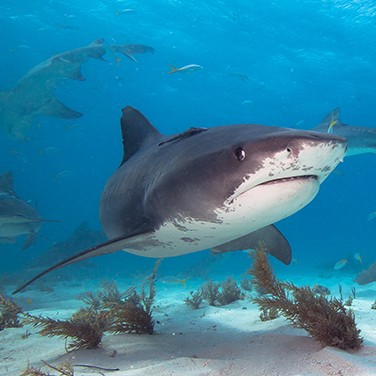Sharks Disappearing in the Fight for Survival
By Mike Howie
The world’s sharks are disappearing. In the waters around Australia — home to nearly half of the world’s 400 species of sharks — researchers found that large apex sharks have declined by 74 to 92 percent. That drastic drop started in the 1960s when a shark control program was put in place to reduce attacks. Since then nearly 50,000 hammerheads, tiger sharks, and great white sharks have been caught using baited lines and nets.
Similar stories are unfolding across the globe. In areas where sharks have a reputation as bloodthirsty killers, they’re hunted in the name of making beaches safer. And where they’re seen as a delicacy, sharks are ravenously fished, fileted, and sold at the local market. In between, they succumb to the pollution and warming waters that affect so much of our sea life. The truth is that sharks are an important part of our ecosystem, and many of them are seriously endangered.
Sharks are tough — famously so. Researchers found shockingly high levels of mercury, arsenic, and lead in the blood of great whites off the coast of South Africa. While the toxins would easily kill most animals at the discovered levels, the sharks were fine. As far as the researchers can tell, they’ve developed a resistance to the heavy metals from eating creatures that are also high in the toxins. But there are some threats that sharks can’t evolve to endure.
Threatened by Fishing, Pollution, and Warming Oceans
One threat is overfishing. According to the World Wildlife Fund (WWF), almost a third of shark species in the Mediterranean Sea have been fished to the brink of extinction. Some species of shark are targeted for food, and others are bycatch — they get caught in nets set for other fish. Shortfin makos, for example, have nearly been hunted to death. They’re the world’s fastest shark, swimming at speeds over 40 mph, and fishermen catch huge numbers of them for their prized meat and fins. While shortfin mako populations have dropped by up to 60 percent in some regions, they aren’t protected by any international fishing restrictions. But the species has been dropped from “vulnerable” to “endangered.”
Another threat to sharks — and all sea life — is the pollution that chokes our oceans. In 2016, a marine biologist in South Carolina found a sandbar shark with plastic twine cutting a ring all the way around the shark’s body. The shark was powerless to free itself, and without human intervention it would have been sliced in half over the course of a few months. And that’s just one of more than a thousand cases of sharks and rays becoming tangled in plastic debris that were documented in a study recently published in Endangered Species Reports. The actual number of cases is surely much higher, but nearly impossible to determine.
Even if sharks can escape all of our fishing lines, nets, and pollution, they cannot escape the oceans, and the waters are getting warmer. Too warm. In fact, the waters around Britain are getting warm enough for hammerheads, great whites, blacktips, and other large species to travel farther north than ever before. There are already about 40 species of sharks in the area — including over 10 million small individuals and about 100,000 larger ones — and in the future Britain could be home to about 60 species of sharks. But as warming waters allow some sharks to migrate farther north, cold-water sharks are left with fewer and fewer places to call home.
Warming waters can also lead to changes in the salinity and acidity of our oceans, which can affect all sea life. Few fish tolerate fresh water, so a drop in ocean salinity can cause an imbalance in their delicate physiology. And a change in acidity could prevent the formation and growth of many marine organisms, which can affect everything from marine habitats to the food chain. Sharks, fish, and other marine life could eventually be left adrift, searching for a dwindling food supply.
What We Could Lose
Without sharks as apex predators, the entire ocean ecosystem could fall out of balance. They not only maintain the species below them in the food chain, but also indirectly maintain seagrass and coral reef habitats. Without them, other predatory fish would reduce the numbers of herbivores, which in turn would allow algae to dominate over coral reefs.
And the loss of sharks would directly affect the world economy as well. Without them, rays and other predators will be left unchecked to devour many of the same sea creatures we eat, forcing fisheries to close. Plus, sharks help drive tourism in many tropical destinations. In the Bahamas, one live reef shark can bring in $250,000 from tourists. And in Belize, a single whale shark can bring in $2 million over its lifetime.
Without doubt, sharks can be frightening creatures. They glide through the ocean with powerful bodies and rows of sharp teeth. They’re some of the most effective hunters the world has ever known. But they also come in myriad beautiful colors, shapes, and sizes. Over the millennia, they’ve evolved to live in nearly every part of our oceans and become an invaluable part of the ocean ecosystem. They’ve fueled stories passed down from generation to generation, and they continue to excite and fascinate us. Surely that’s worth saving.
